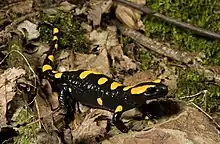| Salamandra longirostris | |
|---|---|
 | |
| Scientific classification | |
| Domain: | Eukaryota |
| Kingdom: | Animalia |
| Phylum: | Chordata |
| Class: | Amphibia |
| Order: | Urodela |
| Family: | Salamandridae |
| Genus: | Salamandra |
| Species: | S. longirostris |
| Binomial name | |
| Salamandra longirostris Joger and Steinfartz, 1994 | |
 | |
| Distribution of the Penibetic salamander | |
| Synonyms[1] | |
|
Salamandra salamandra longirostris Joger and Steinfartz, 1994 | |
Salamandra longirostris, the Penibetic salamander or long-snouted salamander, is a species of urodelan amphibian of the family Salamandridae. It is endemic to the Penibetic mountain range in Andalusia, Spain.[1][2] It was originally described as a subspecies of Salamandra salamandra, the fire salamander, but was raised to full species rank in 2009.[1]
It is a large salamander, very similar to the fire salamander, with which it does not share a distribution area. The body is black with quadrangular yellow spots and some very characteristic spots on the head. The snout is pointed and the belly greyish, without spots.
The spots mark where poison is secreted through the skin.
It lives in humid areas, with watercourses nearby, where it reproduces.
References
- 1 2 3 Frost, Darrel R. (2020). "Salamandra longirostris Joger and Steinfartz, 1994". Amphibian Species of the World: an Online Reference. Version 6.0. American Museum of Natural History. Retrieved 20 January 2020.
- ↑ Masó, A.; Pijoan, M. (2011). Anfibios y reptiles de la península ibérica, Baleares y Canarias. Barcelona: Omega. p. 848. ISBN 978-84-282-1368-4.